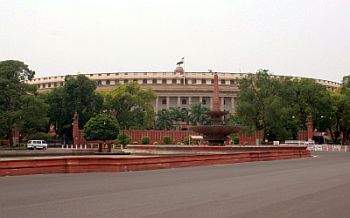After 16 Lok Sabha Elections: Do you think that election system in India should be replaced by proportional representation system?
Civil Services Main Examination
General Studies (Paper - 2) : Model Question & Answers
 Question:
No political party has ever obtained half of the votes cast in any of the 16 Lok
Sabha elections held so far in India and yet half of these Lok Sabhas have seen
single party majority governments. Do you think that the first past the post
election system in India should be replaced by proportional representation
system?
Question:
No political party has ever obtained half of the votes cast in any of the 16 Lok
Sabha elections held so far in India and yet half of these Lok Sabhas have seen
single party majority governments. Do you think that the first past the post
election system in India should be replaced by proportional representation
system?
Answer:-
Advantages of Proportional Representation System
1. Truly represents the voice of people.
2. Will reduce the importance of smaller parties, which often hold the
government to ransom and cause political instability for narrow goals.
3. Will stop the exaggeration of regional differences, by allowing all the
parties with significant levels of support to gain seats across the country.
4. Will stop the inflated seat count of the Blocs controlled by smaller parties
like AIADMK, DMK, SP, BSP, JDU etc. who generally receive less than 10% of the
total votes polled, but a much greater and disproportionate seats.
5. Will bring the nation closer to complete integration of India, putting end to
extreme regionalism, divisive caste and communal politics.
6. Better representation to disadvantaged sections, like minorities and women.
Disadvantages of PR System
1. Political instability. None of the governments formed at centre so far in
India would have been single party majority governments.
2. No link between MPs and geographical constituencies, diluting the
accountability of MPs towards the electorate.
3. May give more fuel to caste and religion based politics.
4. Will not accommodate concerns/interests of the miniscule/smaller castes and
religions.
5. Geographically and culturally distinct smaller areas like North East, Goa, UK
etc may not get any representation in Parliament due to smaller number of votes.
6. Can lead to a majoritarian rule with disregard for regional concerns.
[Candidate may support their arguments according to their stand]
As both FPTP and the PR systems have merits and demerits, experience from
other countries suggests, as has also been noted by the Law Commission of India,
that India would require a hybrid pattern. A mixed-member proportional
representation system, similar to the election of Bundestag in Germany could be
considered.
Further info
In the 2014 Lok Sabha election results:
1. Vote share of largest party, BJP, was 31%, but seat share of 52%.
2. Vote share of 2nd largest party, INC, was 19.3%, but seat share was 8% while
in 2009 election, Vote share of 2nd largest party, BJP, was 18.8% but seat share
was 21.7%.
3. Vote share of 3rd largest party, BSP, was 4.1%, but seat share of 0%.
4. Vote share of 6th largest party, AIADMK, was 3.3%, but seat share of 7%.
data-matched-content-ui-type="image_card_stacked"
Useful Tips & Articles
तैयारी कैसे करें? |
EXAM SUBJECTS |
STUDY RESOURCESDownload Free eBooks |


